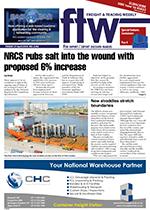Thanks to robust trade growth over the past few months, independent maritime research consultancy Drewry has revised its container growth forecast from 3.6% to 4.3% – with South Asia and Africa identified as the fastest growth markets.
According to Phillip Damas, director of Drewry Supply Chain Advisors, the demand outlook is positive even though supply is expected to grow at a faster rate.
“Last year we saw about 6% growth in worldwide port throughput and we believe this robust growth will continue this year. The International Monetary Fund has also upgraded its GDP forecast for the world,” he said during a recent webinar. “This year’s growth means an additional 9 million TEUs shipped globally which will require a fair amount of capacity.”
According to Damas 2018 is the second year in a row where growth was recorded in every region in the world. “It is for these reasons that we are very confident about the container market at present,” he said. “It is a period of relative optimism in global trade and the global economy.”
He said Africa and South Asia were expected to grow at around 6% while for North America the growth forecast was the lowest at around 3%.
Damas said there had been a global rise in demand with regions such as Asia, Oceania and Latin America expected to grow above 4% at least.
Fleets were managing the supply-demand far better than before, he added.
“2018 could see a big bump for ship capacity due to expected deliveries of new container vessels based on new orders on the current order book,” he said. “From 2019 ship deliveries are very low but we can already see deferrals from 2018 to 2019. It is possible that carriers will try to smooth the schedule of deliveries to improve the supply and demand balance.”
He said the ongoing scrapping of vessels and delivery deferrals of new vessels were keeping net capacity growth at low levels.
The webinar took place before the latest trade hostility between China and the USA. It remains unknown at this stage what impact this will have on container shipping.
In a statement released earlier this month, Simon Heaney, senior manager of container research at Drewry, said a trade war was not yet inevitable, but given the lack of details, quantifying the risk to container shipping was very difficult.
“For example, much of the hi-tech goods considered liable to tariffs will be airfreighted rather than moving on the water. In a worst-case scenario we believe as much as 1% of the world’s loaded container traffic could be exposed, and were the situation to become real we would clearly have to revise our demand forecasts downwards.”
INSERT AND CAPTION
In the case of a trade war as much as 1% of container traffic could be exposed. – Simon Heaney

